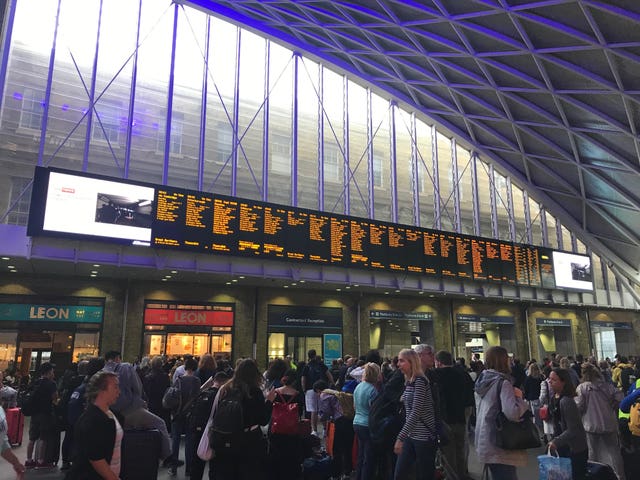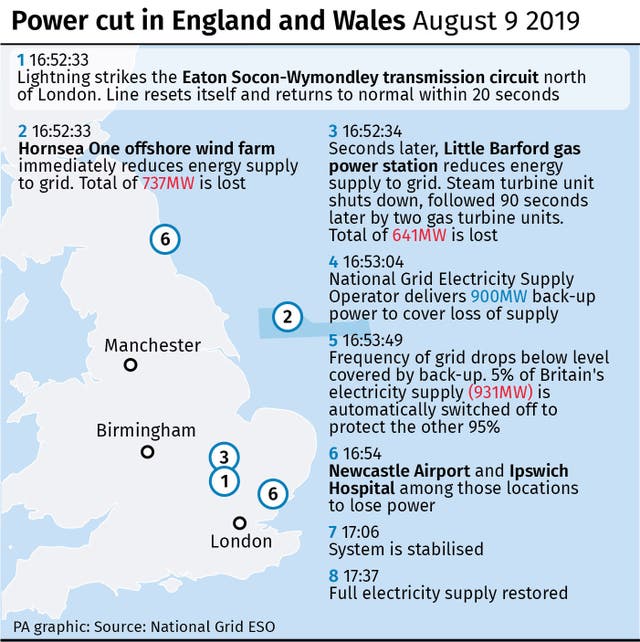A lightning strike on a transmission circuit followed by “almost simultaneous unexpected power losses” at two plants caused blackouts earlier this month which affected around one million customers, an interim report has found.
The outages at Hornsea off-shore wind farm and Little Barford gas power station occurred independently and the scale of generation loss meant that the level of “backup” power required under regulations was insufficient to cover the loss, the report from National Grid Electricity System Operator said.
As a result, the system automatically disconnected customers on the distribution network, with about 5% of electricity demand being turned off to protect the other 95%.

The outage stopped traffic lights from working, plunged Newcastle Airport into darkness, affected Ipswich Hospital, and caused huge disruption on the railways during the busy evening commute, after generation from a gas-fired plant and an offshore wind farm was lost.
The interim report said: “Two almost simultaneous unexpected power losses at Hornsea and Little Barford occurred independently of one another – but each (was) associated with the lightning strike.
“As generation would not be expected to trip off or de-load in response to a lightning strike, this appears to represent an extremely rare and unexpected event.”
The report said the lightning strike was one of many that hit the grid on the day and strikes are “routinely managed as part of normal system operations”.

The report said thousands of rail passengers had their journeys delayed and that some 60 trains operated by Govia Thameslink Railway (GTR) in the South East “reacted unexpectedly to the electrical disturbance” – half of which had required an engineer to be sent out to reset the train.
The issues will be investigated by Network Rail and GTR.
Keith Bell, professor of electrical engineering at the University of Strathclyde, said the report raises the question as to what facilities Network Rail has in the event of power supply losses.
He said: “The event shows the need for and value of system defence measures. However, because it cannot be guaranteed never to trigger them, they need to be implemented in a cost-effective way that minimises the impact on critical supplies.

Industry regulator Ofgem said its investigation would examine the grid’s requirements to hold sufficient back-up power to manage loss of generation supplies, how generators met their obligations with respect to the transmission fault and whether distribution network operators complied with their obligations.
The watchdog also said it would be “looking at whether the companies made the right decisions both in the numbers of customers disconnected and whether those customers disconnected were the right ones”.
Ofgem said it was liaising with the rail regulator and rail authorities “to understand better why the drop in frequency on the energy network led to disruption for passengers”.
The 5% cut, a mechanism known as low frequency demand disconnection (LFDD), is generally understood to try to avoid disruption to critical infrastructure such as hospitals and transport networks and is usually evenly spread across Britain.
Ofgem launches investigation into power cuts ▶️ https://t.co/xxHn2t0olC pic.twitter.com/h9n7TxAIgm
— ofgem (@ofgem) August 20, 2019
Welcoming the report, a National Grid ESO spokesman said it is “right and proper” to have a full investigation into “the performance of the electricity system, and subsequent significant disruption to transports networks and critical infrastructure”.
Investigators are looking at National Grid ESO, National Grid Electricity Transmission, 12 distribution network operators in England and Wales, generators RWE Generation (Little Barford Power station) and Orsted (Hornsea) to see whether any breached their licence conditions.
Ofgem has the power to fine firms found to be at fault up to 10% of their UK turnover.
Jonathan Brearley, Ofgem’s executive director of systems and networks, said: “It’s important that the industry takes all possible steps to prevent this happening again.
“Having now received National Grid ESO’s interim report, we believe there are still areas where we need to use our statutory powers to investigate these outages.
“This will ensure the industry learns the relevant lessons and to clearly establish whether any firm breached their obligations to deliver secure power supplies to consumers.”
The final report is due to be submitted to Ofgem by Friday September 6.
National Grid chief executive John Pettigrew was given a pay rise of almost £1 million this financial year, earning £4.56 million, up from £3.65 million the previous year.
The remuneration committee, according to the firm’s annual report, said he had “continued to deliver strong performance in his third year in the role”.






